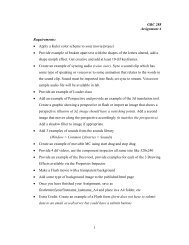Introducing Financial Accounting - CCSN Computer Graphics Program
Introducing Financial Accounting - CCSN Computer Graphics Program
Introducing Financial Accounting - CCSN Computer Graphics Program
Create successful ePaper yourself
Turn your PDF publications into a flip-book with our unique Google optimized e-Paper software.
wiL27041_ch01_002-047.indd Page 12 10/4/10 7:12:32 PM user-f499 /Volumes/204/MHBR211/wiL27041_disk1of1/0073527041/wiL27041_pagefiles<br />
12 Chapter 1 <strong>Introducing</strong> <strong>Financial</strong> <strong>Accounting</strong><br />
EXHIBIT 1.8<br />
Attributes of Businesses<br />
Point: Proprietorships and partnerships<br />
are usually managed by their owners. In a<br />
corporation, the owners (shareholders)<br />
elect a board of directors who appoint<br />
managers to run the business.<br />
Decision Ethics boxes are roleplaying<br />
exercises that stress ethics in<br />
accounting and business.<br />
Point: An audit examines whether<br />
financial statements are prepared using<br />
GAAP. It does not attest to absolute<br />
accuracy of the statements.<br />
Attribute Present Proprietorship Partnership Corporation<br />
One owner allowed . . . . . . . . . . . . yes no yes<br />
Business taxed . . . . . . . . . . . . . . . . no no yes<br />
Limited liability . . . . . . . . . . . . . . . . no* no* yes<br />
Business entity . . . . . . . . . . . . . . . . yes yes yes<br />
Legal entity . . . . . . . . . . . . . . . . . . . no no yes<br />
Unlimited life . . . . . . . . . . . . . . . . . no no yes<br />
* Proprietorships and partnerships that are set up as LLCs provide limited liability.<br />
partners to run a business to gether. The agreement can be either oral or written and usually<br />
indicates how income and losses are to be shared. A partnership, like a proprietorship, is<br />
not legally separate from its owners. This means that each partner’s share of profits is reported<br />
and taxed on that partner’s tax return. It also means unlimited liability for its partners.<br />
However, at least three types of partnerships limit liability. A limited partnership (LP)<br />
includes a general partner(s) with unlimited liability and a limited partner(s) with liability<br />
restricted to the amount invested. A limited liability partnership (LLP) restricts partners’<br />
liabilities to their own acts and the acts of individuals under their control. This protects an<br />
innocent partner from the negligence of another partner, yet all partners remain responsible<br />
for partnership debts. A limited liability company (LLC) offers the limited liability of a<br />
corporation and the tax treatment of a partnership (and proprietorship). Most proprietorships<br />
and partnerships are now organized as LLCs.<br />
3. A corporation, also called C corporation, is a business legally separate from its owner or<br />
owners, meaning it is responsible for its own acts and its own debts. Separate legal status<br />
means that a corporation can conduct business with the rights, duties, and responsibilities<br />
of a person. A corporation acts through its managers, who are its legal agents. Separate<br />
legal status also means that its owners, who are called shareholders (or stockholders),<br />
are not personally liable for corporate acts and debts. This limited liability is its main advantage.<br />
A main disadvantage is what’s called double taxation—meaning that (1) the corporation<br />
income is taxed and (2) any distribution of income to its owners through dividends<br />
is taxed as part of the owners’ personal income, usually at the 15% rate. (For lower income<br />
taxpayers, the dividend tax is less than 15%, and in some cases zero.) An S corporation,<br />
a corporation with special attributes, does not owe corporate income tax. Owners of<br />
S corporations report their share of corporate income with their personal income. Ownership<br />
of all corporations is divided into units called shares or stock. When a corporation<br />
issues only one class of stock, we call it common stock (or capital stock).<br />
Decision Ethics Answer — p. 27<br />
Entrepreneur You and a friend develop a new design for in-line skates that improves speed by 25% to<br />
30%. You plan to form a business to manufacture and market those skates. You and your friend want to<br />
minimize taxes, but your prime concern is potential lawsuits from individuals who might be injured on<br />
these skates. What form of organization do you set up? ■<br />
<strong>Accounting</strong> Constraints There are two basic constraints on financial reporting. The materiality<br />
constraint prescribes that only information that would influence the decisions of a reasonable<br />
person need be disclosed. This constraint looks at both the importance and relative size of<br />
an amount. The cost-benefit constraint prescribes that only information with benefits of disclosure<br />
greater than the costs of providing it need be disclosed.<br />
Sarbanes–Oxley (SOX)<br />
Congress passed the Sarbanes–Oxley Act, also called SOX, to help curb financial abuses at<br />
companies that issue their stock to the public. SOX requires that these public companies apply<br />
both accounting oversight and stringent internal controls. The desired results include more<br />
transparency, accountability, and truthfulness in reporting transactions.









